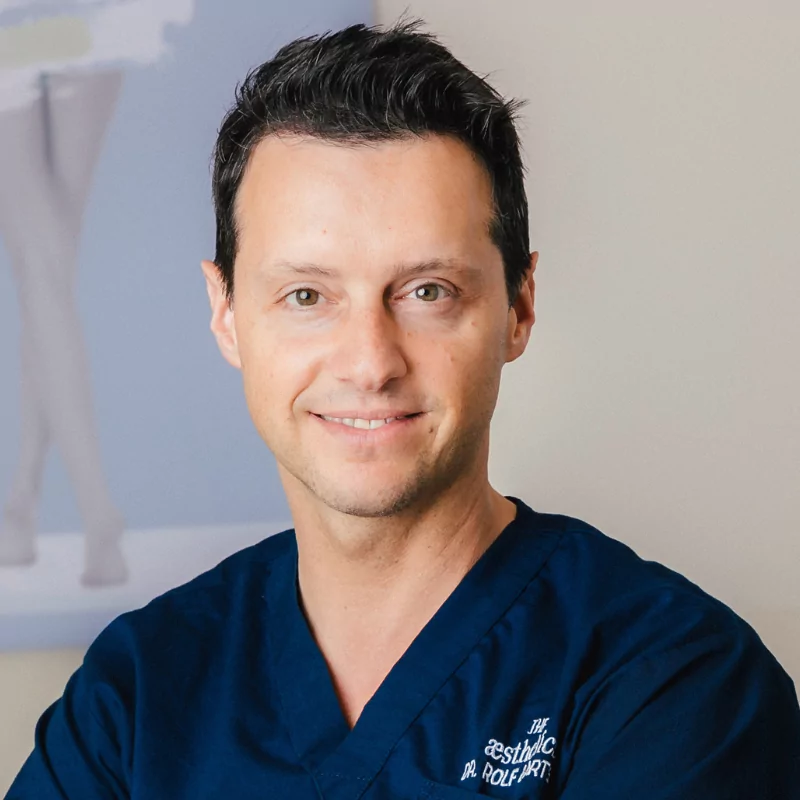How long will my breast implant last?
15. February 2022
The question: "Do I have to change my implant and...



Botox, Hyaluron & Filler. These terms often come to mind in connection with aesthetic as well as plastic surgery. Whether because of the press or the exchange of words with acquaintances: many patients come to us with stories and myths that make our experts smile. But which myths are true and which are fictitious?
We have summarized the most important myths for you.
MYTH ONE: BOTOX IS A NEUROTOXIN
As the saying goes: the dose makes the poison.
Botox or botulinum toxin is a substance that interferes with the transmission of excitation by nerve cells through its inhibitory effect. The substance was first used in medicine in the 1980s. At that time, Botox was used for the treatment of movement disorders and muscle spasms. However, approximately one thousand units were used per treatment. In aesthetic medicine, only 50 – 100 units per treatment are used to smooth out small wrinkles and tighten the tissue. From a medical point of view, Botox is therefore not a poison, but a medicine.
An additional important feature is that the product breaks down completely afterwards. It therefore disappears from the body without leaving any residues. Due to its purely local effect, it cannot travel through the body and only works where it is applied to the muscles. The myth that Botox is a neurotoxin is therefore false!
MYTH TWO: FREQUENT TREATMENT WITH BOTOX CAN PRODUCE ANTIBODIES
An antibody is the body’s own defense against disease. They are formed by contact with foreign substances. In medicine, some incidents are known in which patients have developed antibodies against “botulinum toxin”. This antibody reaction is not due to the botulinum toxin molecule itself, but to a protein that is additionally present in some products. These patients are called “nonresponders”. However, if the patient’s own body develops antibodies against the product, this is not noticeable. The Botox then merely does not reach the muscle, since it was previously fought and repelled, and thus loses its effect. However, this case occurs only very rarely. Moreover, it only occurs with special products. For example, if the doctor uses the product “Bocouture”, which is a “pure” neurotoxin, the development of antibodies is almost impossible.
In general, however, the following applies: Botox should only be injected as often as recommended by the doctor. Because as long as the product is not degraded and new ones are injected, no change or improvement is possible.
There are therefore antibodies against Botox. The myth that these occur, however, with too frequent injections is false!
MYTH THREE: BOTOX IS WORSE THAN HYALURON
Botox and hyaluronic acid are probably the most commonly used products in aesthetic medicine. Especially in the face, they are used to smooth small wrinkles and tighten the skin. Hyaluronic acid is like a substance produced naturally in the body. It binds the water under the uppermost skin layer and thus ensures smoothing. However, the fact that Botox is “worse” cannot be generalized in any case. Because with hyaluronic acid as a filler substance, complications occur much more frequently than with Botox.
In general, it depends on the individual patient which product is most suitable for him or her. The product used depends not only on the nature of the tissue, but also on the area to be injected and treated. Botulinum toxin and hyaluron therefore work differently and cannot be exchanged for each other according to the motto “I would rather have…”.
The myth that Botox is worse than hyaluron is therefore just as false.
MYTH FOUR: BOTOX MAKES LIPS PARTICULARLY BEAUTIFUL
Many rumors about Botox, fillers & Co. circulate especially through the tabloid press. Injecting the lips with Botox is one of the most popular rumors. However, this myth is false! Because Botox can be used to treat dynamic wrinkles such as those on the forehead or temples (frown lines, crow’s feet, etc.), but not the lips. Therefore, only hyaluronic acid and NOT Botox is used to model lips. Hyaluronic acid is mostly used in aesthetic medicine, in addition to smoothing small wrinkles, to restore volume and thus help the tissue to regain its elasticity. It is perfect for injecting into the lips to achieve beautiful and natural results. Botox, on the other hand, is not suitable for this purpose, as it only works on the target muscles and minimizes their movement.
MYTH FIVE: THE MORE OFTEN I HAVE MYSELF TREATED WITH HYALURON, THE EARLIER I AGE AND THE MORE OFTEN I HAVE TO “RE-INJECT”!
The aging process is a natural process of the body, which medical substances or treatments can neither stop nor accelerate. However, aesthetic medicine treatments can touch up small subtleties and bring back a youthful freshness. Hyaluronic acid is a good helper in this case. It stabilizes the tissue through new volume and makes the skin look plumper. However, it is simply wrong to assume that frequent injections will cause the skin to age more quickly and therefore require more frequent injections! Hyaluron is broken down by the body after some time. The formation of wrinkles cannot be stopped by hyaluron, but the expression can be minimized. Because of the bound water under the skin, the wrinkles are evened out for a longer period of time and much faster than through the body’s own production of collagen. Therefore, the treatment with hyaluron does not make me age faster. However, one should inject only as often as recommended by the treating physician, because an excessive dose does not show a better effect, but often causes disproportionate results.
OUR RECOMMENDATION
There are many myths about Botox, fillers & Co. And just as many answers circulate on the World Wide Web as well as in the tabloid press. As a patient, it is best to discuss your questions and wishes personally with a doctor in order to work out an individual treatment concept together and thus achieve optimal results.
We welcome your feedback at [email protected]
You need to load content from reCAPTCHA to submit the form. Please note that doing so will share data with third-party providers.
More InformationYou are currently viewing a placeholder content from Facebook. To access the actual content, click the button below. Please note that doing so will share data with third-party providers.
More InformationYou need to load content from reCAPTCHA to submit the form. Please note that doing so will share data with third-party providers.
More InformationYou are currently viewing a placeholder content from Instagram. To access the actual content, click the button below. Please note that doing so will share data with third-party providers.
More InformationYou are currently viewing a placeholder content from Instagram. To access the actual content, click the button below. Please note that doing so will share data with third-party providers.
More InformationYou are currently viewing a placeholder content from Google Maps. To access the actual content, click the button below. Please note that doing so will share data with third-party providers.
More InformationYou are currently viewing a placeholder content from X. To access the actual content, click the button below. Please note that doing so will share data with third-party providers.
More Information